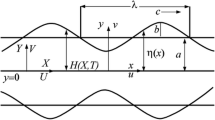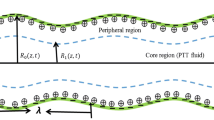Abstract
Utilizing an electronic–hydraulic analogy, this study develops an equivalent electrical network of a piezoelectric peristaltic micropump which has not been modeled the whole system operation completely by computational fluid dynamics (CFD) or equivalent electrical network so far due to its excessive complicated structure. The validity of the proposed model is verified by comparing the simulation results obtained using the SPICE (simulation program with integrated circuit emphasis) software package for flow rate spectrum and its maximum state of a typical micropump with the experimental observations for two working fluids, namely DI water and blood. The simulation results predict a maximum flow rate frequency and flow rate of 280 Hz and 43.23 μL/min, respectively, for water, and 210 Hz and 24.12 μL/min for blood. The corresponding experimental results are found to be 300 Hz and 41.58 μL/min for water and 250 Hz and 23.75 μL/min for blood. The relatively poorer agreement between the two sets of results when using blood as the working fluid is thought to be the result of the non-Newtonian nature of blood, which induces a more complex, non-linear flow behavior within the micropump. Having validated the proposed model, the equivalent network is used to perform a systematic analysis of the correlation between the principal micropump design parameters and operating conditions and the micropump performance. The results confirm the validity of the equivalent electrical network model as the first microfluidic modeling tool for optimizing the design of peristaltic micropumps and for predicting their performance.












Similar content being viewed by others
References
Bourouina T, Grandchamp JP (1996) Modeling micropumps with electrical equivalent networks. J Micromech Microeng 6:398–404
Darabi J, Rhodes C (2006) CFD modeling of an ion-drag micropump. J Sens Actuators A Phys 127:094–103
Gong QL, Zhou ZY, Yang YH, Wang XH (2000) Design, optimization and simulation on microelectromagnetic pump. J Sens Actuators A Phys 83:200–207
Hsu YC, Chen TY (2007) Applying Taguchi methods for solvent-assistant PMMA bonding technique for static and dynamic μ-TAS devices. J Biomed Microdevices 9:513–522
Hsu YC, Le NB (2008) Inertial effects on flow rate spectrum of diffuser micropumps. J Biomed Microdevices 10:681–692
Hsu YC, Lin SJ, Hou CC (2008) Development of peristaltic antithrombogenic micropumps for in vitro and ex vivo blood transportation tests. J Microsyst Technol 14:31–41
Jang LS, Li YJ, Lin SJ, Hsu YC, Yao WS, Tsai MC (2007) A stand-alone peristaltic micropump based on piezoelectric actuation. J Biomed Microdevices 9:185–194
Jiang TY, Nguyen TY, Lam KY (2000) Dynamic analysis of an electrostatic micropump. In: Proceedings of international conference modeling and simulation of microsystems, San Diego, pp 632–35
Kaltenbacher M, Landes H, Lerch R, Lindinger F (1997) A finite-element/boundary-element method for the simulation of coupled electrostatic–mechanical systems. J Physique III 7:1975–1982
Morganti E, Fuduli I, Montefusco A, Petasecca M, Pignatel GU (2005) SPICE modelling and design optimization of micropumps. Int J Environ Anal Chem 85:687–698
Morris CJ, Forster FK (2000) Optimization of a circular piezoelectric bimorph for a micropump driver. J Micromech Microeng 10:459–465
Richter M, Linnemann R, Woias P (1998) Robust design of gas and liquid micropumps. Sens Actuators A 68:480–486
Smits JG (1990) Piezoelectric micropump with three valves working peristaltically. J Sens Actuators A Phys 21:203–206
Ullmann A, Fono I (2002) The piezoelectric valve-less pump-improved dynamic model. J MEMS 11:655–664
Wang BW, Chu XC, Li EZ, Li LT (2006) Simulations and analysis of a piezoelectric micropump. J Ultrason 44:643–646
Acknowledgments
The authors gratefully acknowledge the financial support provided to this study by the National Science Council of the Republic of China, Taiwan, under Contract No. NSC 96-2221-E-218-033. The authors would also like to thank National Nano Device Laboratories, Center for Micro/Nano Technology Research for their assistance in fabricating the micropumps used in this study.
Author information
Authors and Affiliations
Corresponding author
Rights and permissions
About this article
Cite this article
Hsu, Y.C., Le, N.B. Equivalent electrical network for performance characterization of piezoelectric peristaltic micropump. Microfluid Nanofluid 7, 237–248 (2009). https://doi.org/10.1007/s10404-008-0380-7
Received:
Accepted:
Published:
Issue Date:
DOI: https://doi.org/10.1007/s10404-008-0380-7




